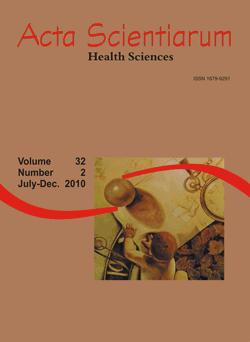<b>Medicinal use of the Aloe and Chamomile for the urban population of Cascavel, Paraná State</b> - doi: 10.4025/actascihealthsci.v32i2.6446
Keywords:
Aloe vera L., Matricaria chamomilla L., ethnobotany, medicinal plants
Abstract
The ethnobotany, which is characterized by look for to understand the relationship between the plants and the man, being been able through this to know the use of the medicinal plants as treatment. The objective of this work was to accomplish a rising on the forms of use of the Aloe (Aloe vera L.) and of the Chamomile (Matricaria chamomilla L.). The collection of data involved interviews in a random way to a sample of 400 people through a semi-structured questionnaire, in the city of Cascavel, Paraná State. It was observed that 65% of the population use to aloe or the chamomile in the cure or relief of diseases. Most of the interviewees possesses income from 2 to 4 minimum wages (60.25%), age between 28 to 38 years (30.75%), having concluded the high school (33.75%). The main reason for which the population is used of medicinal plants is for being natural (71.84%). The form of more frequent preparation of the chamomile was for infusion (63.38%), using the flowers (92%). To the aloe, 100% uses their leaves in the cataplasm form (43.88%). Only 3% of the population told to have presented some type of adverse reaction, during the use period. Is it conclued ended that the use of these plants for the population is frequent, being an additional resource to the use of medicines.Downloads
Download data is not yet available.
Published
2010-09-28
How to Cite
Paula, K. B. da S. de, & Cruz-Silva, C. T. A. (2010). <b>Medicinal use of the Aloe and Chamomile for the urban population of Cascavel, Paraná State</b> - doi: 10.4025/actascihealthsci.v32i2.6446. Acta Scientiarum. Health Sciences, 32(2), 169-176. https://doi.org/10.4025/actascihealthsci.v32i2.6446
Issue
Section
Pharmacy
DECLARATION OF ORIGINALITY AND COPYRIGHTS
I Declare that current article is original and has not been submitted for publication, in part or in whole, to any other national or international journal.
The copyrights belong exclusively to the authors. Published content is licensed under Creative Commons Attribution 4.0 (CC BY 4.0) guidelines, which allows sharing (copy and distribution of the material in any medium or format) and adaptation (remix, transform, and build upon the material) for any purpose, even commercially, under the terms of attribution.
Read this link for further information on how to use CC BY 4.0 properly.























5.png)







